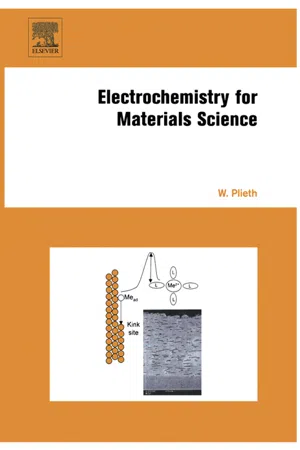
- 420 pages
- English
- ePUB (mobile friendly)
- Available on iOS & Android
Electrochemistry for Materials Science
About This Book
This book introduces the principles of electrochemistry with a special emphasis on materials science. This book is clearly organized around the main topic areas comprising electrolytes, electrodes, development of the potential differences in combining electrolytes with electrodes, the electrochemical double layer, mass transport, and charge transfer, making the subject matter more accessible.In the second part, several important areas for materials science are described in more detail. These chapters bridge the gap between the introductory textbooks and the more specialized literature. They feature the electrodeposition of metals and alloys, electrochemistry of oxides and semiconductors, intrinsically conducting polymers, and aspects of nanotechnology with an emphasis on the codeposition of nanoparticles.This book provides a good introduction into electrochemistry for the graduate student. For the research student as well as for the advanced reader there is sufficient information on the basic problems in special chapters. The book is suitable for students and researchers in chemistry, physics, engineering, as well as materials science.- Introduction into electrochemistry- Metal and alloy electrodeposition- Oxides and semiconductors, corrosion- Intrinsically conducting polymers- Codeposition of nanoparticles, multilayers
Frequently asked questions
Information
Electrolytes
Publisher Summary
1.1 LIQUID ELECTROLYTE SOLUTIONS
Table of contents
- Cover image
- Title page
- Table of Contents
- List of Symbols
- Preface
- Chapter 1: Electrolytes
- Chapter 2: Structure and Bonding
- Chapter 3: Electrode Potentials
- Chapter 4: Ad-Atoms and Underpotential Deposition
- Chapter 5: Mass Transport
- Chapter 6: Charge Transfer
- Chapter 7: Nucleation and Growth of Metals
- Chapter 8: Deposition of Alloys
- Chapter 9: Oxides and Semiconductors
- Chapter 10: Corrosion and Corrosion Protection
- Chapter 11: Intrinsically Conducting Polymers
- Chapter 12: Nanoelectrochemistry
- Index